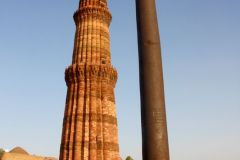The tallest brick minaret in the world, the Qutb Minar, was built as a victory tower after 1192. It was developed during the next centuries until it reached its present height of 72.5 m.
The UNESCO World Heritage List includes more than a thousand properties with outstanding universal value. They are all part of the world’s cultural and natural heritage.
Official facts
- Full name of site: Qutb Minar and its Monuments, Delhi
- Country: India
- Date of Inscription: 1993
- Category: Cultural site
UNESCO’s World Heritage Centre’s short description of site no. 233:
Built in the early 13th century a few kilometres south of Delhi, the red sandstone tower of Qutb Minar is 72.5 m high, tapering from 2.75 m in diameter at its peak to 14.32 m at its base, and alternating angular and rounded flutings. The surrounding archaeological area contains funerary buildings, notably the magnificent Alai-Darwaza Gate, the masterpiece of Indo-Muslim art (built in 1311), and two mosques, including the Quwwatu’l-Islam, the oldest in northern India, built of materials reused from some 20 Brahman temples.
My visit
The tower, or minaret, of Qutub Minar stands within a large complex with several other buildings. Arriving here under the setting sun on a Sunday, I found the lawns and ruins filled with locals enjoying a day out. There are plenty of impressive stone carvings to keep you entertained for a long time. Most date back to the same time period as the minaret. The strange iron pillar standing near the minaret dates as far back as 402 AD.











